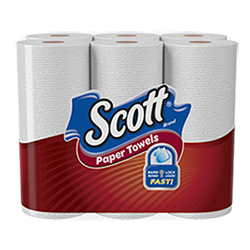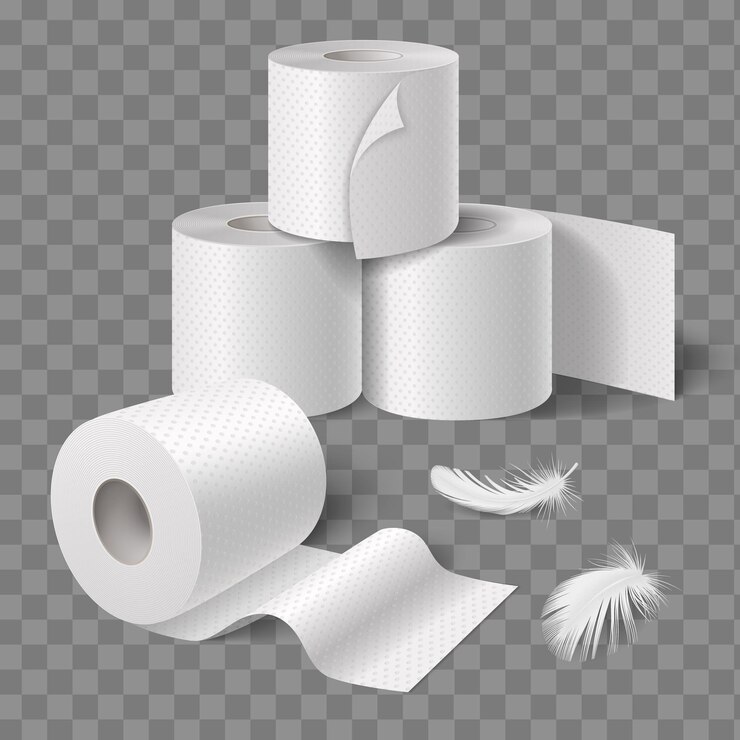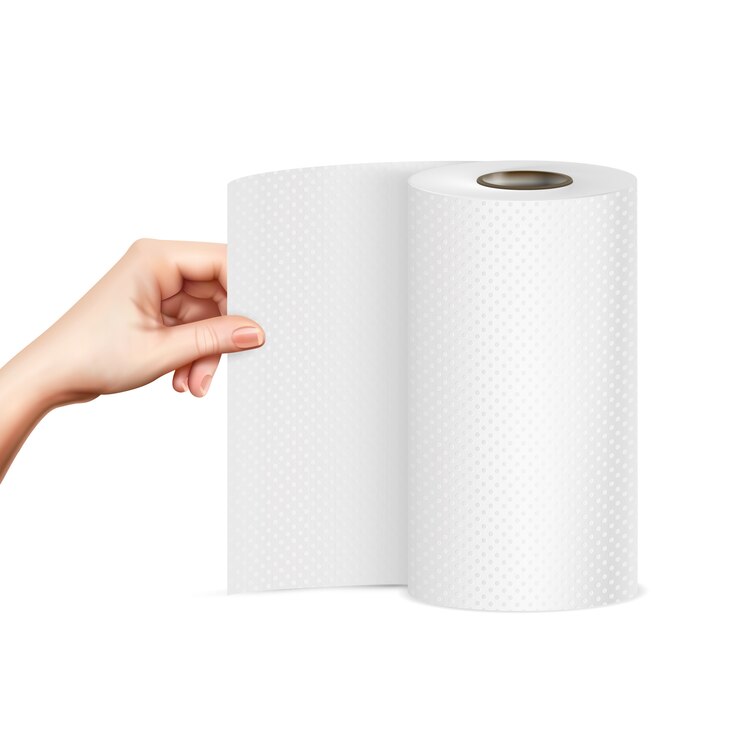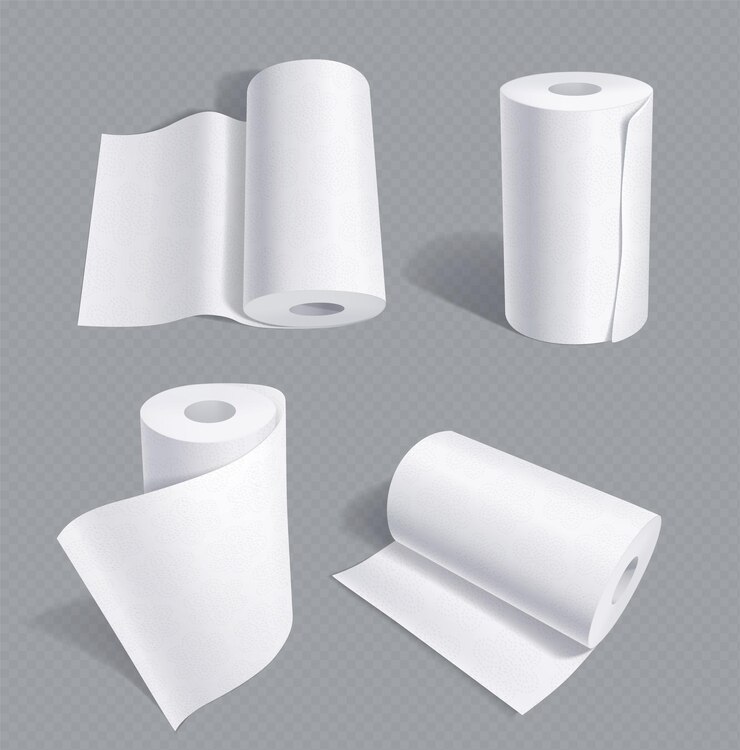Embark on this fascinating exploration of paper towel history. Discover the evolution, cultural impact, and eco-friendly innovations that shaped this everyday essential.
Introduction
In our fast-paced world, the humble paper towel might seem like a mundane necessity. However, delving into paper towel history unveils a fascinating journey of evolution, innovation, and cultural significance. Let’s unroll the tale of how paper towels transformed from simple sheets to indispensable tools in our daily lives.
When were paper towels invented?
Indepth study of paper towel history reveals that paper towels were accidentally invented in 1907 by Arthur Scott, son of Irvin Scott, co-founder of the Scott Paper Company. A shipment of paper intended for toilet paper arrived at the factory, but it was too thick and unsuitable for its intended purpose. Rather than discard the entire batch, Arthur Scott had the idea of converting the excess paper into disposable towels for public restrooms. These early paper towels, known as Sani-Towels, were primarily used in public places like schools, hospitals, and offices.
Who was Arthur Scott?
Arthur Hoyt Scott (1875-1927) was the son of Irvin Scott, co-founder of the Scott Paper Company. He played a pivotal role in shaping the company’s direction and establishing its signature product, Scott Paper Towels.

Born in Philadelphia in 1875, Arthur Hoyt Scott grew up immersed in the paper industry. His father, Irvin Scott, had founded the Scott Paper Company in 1872, and young Arthur developed a keen understanding of the business. After graduating from Swarthmore College in 1897, Arthur joined the family company and quickly rose through the ranks.
In 1902, Arthur Scott made a transformative decision that would shape the company’s future. He recognized the potential of disposable paper towels and urged his father to begin manufacturing their own brand. This decision led to the creation of Scott Sani-Towels, the first commercially successful disposable paper towels.
Arthur Scott’s vision and leadership extended beyond product development. He also implemented innovative marketing strategies that emphasized the convenience and hygiene of paper towels, helping to popularize their use in homes, schools, and businesses alike. Under his guidance, Scott Paper Towels became a household staple, revolutionizing the way people cleaned up spills, dried hands, and tackled everyday messes.

Arthur Scott’s contributions to the Scott Paper Company and the paper industry were immense. He transformed a small, local paper mill into a national leader in disposable paper products, establishing a legacy that continues to this day. His entrepreneurial spirit, marketing acumen, and commitment to innovation made him a true pioneer in the paper industry.
Paper Towel History: Evolution of Paper Towels
When we look at 115 years of paper towel history, they have undergone significant advancements in terms of their design, functionality, and environmental impact. Here’s a timeline showcasing the key milestones in the evolution of paper towels:
1907: Accidental Discovery of Paper Towels
The story of paper towels begins with a serendipitous moment in 1907 when Arthur Scott, son of Irvin Scott, co-founder of the Scott Paper Company, stumbled upon an unexpected solution. A shipment of paper intended for toilet paper arrived at the factory, but it was too thick for its intended purpose. Rather than discarding the entire batch, Arthur Scott had the idea of converting the excess paper into disposable towels for public restrooms. These early paper towels, known as Sani-Towels, were primarily used in public places like schools, hospitals, and offices.
1922: Nibroc Paper Towels and the Introduction of Kraft Paper
In 1922, the Brown Company introduced Nibroc Paper Towels, marking a significant step forward in the development of paper towels. Nibroc towels were made from a new type of absorbent paper called kraft, which offered superior strength and absorbency compared to previous paper towels. This innovation paved the way for the widespread adoption of paper towels in households.
1931: Paper Towels Enter the Kitchen
The study of paper towel history discloses a major breakthrough came in 1931 when the Scott Paper Company introduced paper towels specifically designed for kitchen use. These towels were larger and more absorbent than their predecessors, making them ideal for cleaning up spills, wiping down surfaces, and tackling various kitchen tasks. The introduction of kitchen paper towels revolutionized household cleaning and further cemented their place in modern life.
Post-World War II Boom and Environmental Concerns
Durig the study of paper towel history, it has also been explored that after World War II, the use of paper towels skyrocketed as households embraced their convenience and disposable nature. Paper towels became a staple in kitchens, bathrooms, and other areas of the home, replacing cloth towels in many instances. However, this increased consumption brought about environmental concerns. The production of paper towels requires vast amounts of trees and water, and the disposal of used paper towels contributes to landfill waste.
Early Substitutes for Paper Towels
Study of paper towel history reveals that before the convenience of disposable paper towels, our ancestors relied on reusable cloth towels and natural materials for their cleaning and drying needs. The concept of single-use absorbent sheets was yet to be conceived.
Invention of Disposable Paper Towels
The breakthrough in paper towel history occurred with the invention of disposable versions. In the early 20th century, companies began producing these convenient, single-use sheets, forever changing the way we approached cleanliness and convenience.

Sustainability Efforts and Eco-Friendly Alternatives
In response to growing environmental concerns, manufacturers have explored new ways to produce paper towels using more sustainable materials and processes. Recycled paper has become a common source of material for paper towels, reducing the reliance on virgin trees. Additionally, manufacturers are developing paper towels with enhanced absorbency, allowing consumers to use fewer sheets, thereby reducing waste.
Alongside advancements in paper towel production, there has been a growing movement towards more sustainable alternatives, such as reusable cloth towels and eco-friendly disposable towels made from recycled materials. Reusable cloth towels offer a long-term, environmentally friendly solution, while eco-friendly disposable towels provide a more sustainable alternative to traditional paper towels.
Study of Paper Towel History: From Tissue to Towels
The story about paper towel history begins in the late 19th century with the Scott Paper Company, founded in 1879 by brothers Clarence and Irvin Scott. Initially, the company produced toilet paper, but in 1890, they introduced a new product called Sani-Scotia, a crepe-textured paper designed for facial cleansing and handkerchiefs.
In 1907, a fortuitous incident led to the birth of paper towels. A shipment of paper intended for toilet paper arrived at the Scott factory, but the paper was too thick and unsuitable for its intended purpose. Rather than discard the entire batch, Arthur Scott, Irvin’s son, had the idea of converting the excess paper into disposable towels for public restrooms.
These early paper towels were marketed as Sani-Towels and were primarily used in public places like schools, hospitals, and offices. They were advertised as a hygienic alternative to communal cloth towels, which were believed to spread germs and diseases.
Paper Towel History: From Public Restrooms to Home Kitchens
The concept of paper towels gradually gained acceptance, and in the 1920s, companies began experimenting with different types of paper and manufacturing processes to improve their absorbency and softness. In 1922, the Brown Company introduced Nibroc Paper Towels, which were made from a new type of absorbent paper called kraft.
In 1931, the Scott Paper Company made a significant breakthrough by introducing paper towels specifically designed for kitchen use. These towels were larger and more absorbent than their predecessors, making them ideal for cleaning up spills and wiping down surfaces.

Widespread Adoption and Environmental Concerns in Paper Towel History
After World War II, the use of paper towels exploded as households embraced the convenience and disposable nature of these products. Paper towels became a staple in kitchens, bathrooms, and other areas of the home, replacing cloth towels in many instances.
However, the widespread adoption of paper towels also raised environmental concerns. The production of paper towels requires a significant number of trees and water, and the disposal of used paper towels contributes to landfill waste.
In recent years, there has been a growing movement towards more sustainable alternatives to paper towels, such as reusable cloth towels and eco-friendly disposable towels made from recycled materials.
Key Milestones in Paper Towel History
Introduction of Perforated Rolls
One pivotal milestone in the paper towel history was the introduction of perforated rolls. This innovation, which allowed easy tearing of individual sheets, marked a turning point in user convenience and paved the way for mass production.
Development of Absorbent Technologies in paper towel history
Scientific advancements played a crucial role in enhancing the absorbency of paper towels. From early experiments to cutting-edge technologies, the quest for better absorption transformed the user experience, making paper towels more effective in various applications.
Incorporation of Recycled Materials
As environmental concerns gained prominence, the paper towel industry responded by incorporating recycled materials. This eco-friendly shift aimed to address disposability issues and minimize the environmental impact of paper towel production.
Impact on Hygiene Practices in Paper Towel History
Role in Promoting Cleanliness
Exploring the paper towel history also shows that paper towels emerged as a game-changer in promoting cleanliness, offering a convenient and effective solution for wiping surfaces, hands, and more. Their disposable nature significantly contributed to maintaining a hygienic environment in both households and public spaces.
Adoption in Households and Public Spaces
The widespread adoption of paper towels speaks volumes about their effectiveness. From kitchens to public restrooms, these disposable sheets became an integral part of maintaining cleanliness and hygiene standards.
Environmental Considerations in Paper Towel History
Challenges of Disposability
While paper towels provided unmatched convenience, the issue of disposability raised concerns. The sheer volume of discarded sheets contributed to environmental challenges, leading to a reassessment of the industry’s environmental footprint.
Eco-friendly Innovations in Paper Towel History
In response to environmental challenges, the paper towel industry embraced eco-friendly innovations. From incorporating recycled materials to exploring sustainable production methods, the goal shifted towards balancing convenience with environmental responsibility.
Popular Brands and Innovations in Paper Towel History
Overview of Leading Paper Towel Brands
In the competitive realm of paper towels, several brands have risen to prominence. Names like Bounty, Viva, and Brawny dominate the market, each offering a unique blend of absorbency, strength, and quality. These brands have not only become household names but also set the standard for what consumers expect from a reliable paper towel.
Notable Industry Innovations in the Paper Towel History
The paper towel industry has witnessed remarkable innovations over the years. From the introduction of select-a-size sheets that allow users to choose the perfect size for their needs to the integration of enhanced absorbent technologies, innovations continue to elevate the functionality and efficiency of paper towels. Brands are consistently pushing boundaries to meet the evolving demands of consumers.

Usage Statistics in Paper Towel History
Consumption Trends Over the Years
The consumption of paper towels has experienced significant trends over the years. As lifestyles evolve and hygiene standards rise, there has been a steady increase in the use of paper towels, both in households and public spaces. The convenience offered by disposable paper towels has contributed to their widespread adoption.
Regional Variations in Usage Patterns
Study of paper towel history depicts that usage patterns vary across regions due to cultural practices, economic factors, and environmental awareness. While some areas exhibit a higher reliance on paper towels, others may prioritize reusable alternatives. Understanding these variations provides valuable insights into the diverse ways different cultures approach cleanliness and convenience.
Cultural Significance in Paper Towel History
Rituals and Traditions Involving Paper Towels
Beyond their practical uses, paper towels hold cultural significance in various rituals and traditions. From ceremonial hand-washing to symbolic gestures in religious practices, these seemingly mundane sheets play a role in cultural rituals worldwide.
Symbolism in Various Cultures
In different cultures, paper towels take on symbolic meanings. Whether representing purity, practicality, or even luxury, these interpretations shed light on the cultural significance attached to everyday items. Understanding these symbols deepens our appreciation for the role paper towels play in diverse societies.
Industry Challenges in Paper Towel History
Supply Chain Disruptions
The paper towel industry faces challenges related to supply chain disruptions. Natural disasters, global events, and unforeseen circumstances can impact the production and distribution of paper towels, leading to shortages and logistical challenges.
Quality Control Issues
Maintaining quality control is a persistent challenge in the paper towel industry. From ensuring the strength and absorbency of each sheet to addressing manufacturing defects, brands continually work to uphold the reliability of their products.
Future Trends
Technological Advancements in Paper Towel Production
The future of paper towels holds exciting technological advancements. Smart packaging, infused with features to enhance user experience, and innovations in materials aim to make paper towels more functional and sustainable.
Growing Focus on Sustainability
A notable trend shaping the future of paper towels is a growing emphasis on sustainability. From biodegradable options to eco-friendly packaging, the industry is actively exploring ways to reduce its environmental impact and meet the demands of environmentally conscious consumers.
Tips for Choosing the Right Paper Towel
Factors to Consider When Purchasing
When selecting the right paper towel, factors such as absorbency, strength, and sheet size are crucial. Understanding your specific needs and preferences will guide you towards a choice that aligns with your expectations.
Environmentally Conscious Choices
For those concerned about the environmental impact, opting for paper towels made from recycled materials or those with eco-friendly certifications can make a positive difference. Being mindful of your choices contributes to sustainability efforts.
DIY Paper Towel Alternatives
Homemade Alternatives
Discover a world of sustainable choices with these simple and effective DIY alternatives to commercial paper towels. These homemade options not only provide practical solutions for your everyday needs but also contribute to a greener, more eco-friendly lifestyle.
Reusable Cloth Options
Swap out disposable paper towels for reusable cloth alternatives. Cut old t-shirts or towels into squares to create washable and durable cloth towels. These can be used for various cleaning tasks and are easily tossed into the laundry for reuse.
Homemade Cleaning Wipes
Craft your own cleaning wipes using easily available ingredients. Mix a solution of water, vinegar, and a few drops of essential oil for a natural cleaning solution. Soak cloth squares in the solution and store them in a reusable container. These DIY cleaning wipes are not only effective but also reduce the need for disposable cleaning products.
Impact on Reducing Waste
Embracing DIY paper towel alternatives goes beyond just finding practical substitutes — it’s a conscious choice with a positive impact on the environment. By adopting these homemade options, individuals can actively contribute to reducing waste and fostering a more sustainable lifestyle.
Positive Environmental Impact
The environmental benefits of DIY alternatives are substantial. By using reusable cloth options and homemade cleaning wipes, individuals significantly decrease their reliance on single-use paper towels. This reduction in paper waste contributes to fewer trees being cut down and less energy consumed in the manufacturing process.
Adding a Personal Touch to Eco-Friendly Living
Beyond their environmental impact, DIY alternatives add a personal touch to the journey of eco-friendly living. Crafting your own cleaning solutions and reusable cloth towels not only reduces waste but also allows you to tailor these alternatives to your preferences, from choosing scents in your cleaning solution to selecting fabrics for your cloth towels.
Join the Quest for Eco-Friendly Living
Incorporating DIY paper towel alternatives into your daily routine is a small yet impactful step towards a more sustainable lifestyle. As you embark on this quest, you not only reduce your ecological footprint but also inspire others to make mindful choices for the well-being of our planet.
The Role of Paper Towels in Emergency Situations
Uses in Emergencies and Disasters
In emergencies and disasters, paper towels serve versatile purposes. From improvised bandages to quick cleanup solutions, their absorbent and disposable nature makes them valuable tools in challenging situations.
Contributions to Disaster Relief Efforts
Paper towels contribute to disaster relief efforts by providing essential hygiene solutions in temporary shelters. Their accessibility and ease of use make them a practical choice for humanitarian aid organizations.
Art and Craft in Paper Towel History
Creative Uses Beyond Cleaning
Let’s journey beyond the mundane functionality of paper towels and explore the artistic possibilities these everyday items hold. From humble kitchen essentials to artistic mediums, discover how paper towels can be transformed into a canvas for creativity, adding a touch of ingenuity to the ordinary.
Paper Towel Canvas Paintings
Turn your roll of paper towels into a canvas for expressive paintings. The absorbent nature of the paper provides a unique texture, allowing colors to blend and flow in unexpected ways. Experiment with watercolors or acrylics to create abstract masterpieces that showcase the versatility of this unassuming material.
Paper Towel Sculptures
Shape and mold paper towels into intricate sculptures. The pliability of the material lends itself to creating three-dimensional forms. From delicate flowers to abstract figures, explore the limitless possibilities of crafting beautiful sculptures with just a roll of paper towels and a dash of imagination.
Decoupage Magic
Transform everyday objects with the art of decoupage using paper towels. Apply carefully selected images or patterns to surfaces such as furniture, vases, or even wooden trays. The absorbency of the paper towels helps to adhere the images seamlessly, resulting in personalized and visually stunning creations.
DIY Projects for Kids and Adults
Unleash the artistic potential within a simple roll of paper towels with engaging DIY projects suitable for both kids and adults. These projects not only provide a creative outlet but also showcase the versatility of paper towels as a crafting material.

Paper Towel Roll Animals for Kids
For young crafters, turn empty paper towel rolls into a menagerie of animals. From colorful snakes to quirky insects, the cylindrical shape of the rolls serves as the perfect base for creating a zoo’s worth of critters. Add paint, googly eyes, and other craft supplies to bring these creatures to life.
Paper Towel Mache for Adults
Explore the world of paper towel mache for more intricate creations. Whether crafting decorative masks, intricate bowls, or unique sculptures, the combination of paper towels, glue, and a bit of patience opens doors to crafting one-of-a-kind pieces. The absorbent nature of the paper towels ensures a smooth finish for your artistic endeavors.
Paper Towel Stamping Art
Indulge in the timeless art of stamping with paper towels. Create custom patterns and designs by dipping bunched-up paper towels into paint and stamping them onto various surfaces. This technique is versatile and can be applied to everything from greeting cards to canvas paintings, making it a delightful and accessible project for artists of all ages.
The Future of Paper Towels: Balancing Convenience and Sustainability
As we move forward, the future of paper towels will likely involve a balance between convenience and sustainability. Manufacturers are exploring new ways to produce paper towels using more sustainable materials and processes, while consumers are increasingly aware of the environmental impact of their choices.
It is likely that we will see a continued shift towards reusable cloth towels and more eco-friendly disposable options, but paper towels are likely to remain a popular choice for many consumers due to their convenience and absorbency.
The Enduring Appeal of Paper Towels: Convenience and Versatility
Despite the growing emphasis on sustainability, paper towels remain a popular choice for many consumers due to their undeniable convenience and versatility. Here are some of the reasons why paper towels continue to be a mainstay in households and businesses:
Unmatched Absorbency
Paper towels are engineered to absorb liquids effectively, making them ideal for cleaning up spills, drying hands, and handling various messy tasks. Their absorbency ensures that surfaces are left clean and dry, preventing the spread of germs and maintaining hygiene.
Disposable Convenience:
Paper towels offer the ultimate in convenience, as they can be used once and then discarded, eliminating the need for washing and drying reusable towels. This disposable nature saves time and effort, making paper towels a practical choice for busy households and workplaces.
Versatility in Use:
Paper towels are incredibly versatile and can be used for a wide range of tasks beyond simply cleaning up spills and drying hands. They can be used to wipe down surfaces, remove dust and grime, absorb excess grease, and even as makeshift bandages or filters.
Variety of Options:
Paper towels come in a variety of sizes, textures, and absorbency levels to suit different needs and preferences. There are thin, quick-drying towels for everyday use, thicker towels for heavy-duty cleaning, and even perforated towels for specific applications like wiping up grease.
Affordable and Accessible:
Paper towels are generally affordable and readily available in supermarkets, convenience stores, and online retailers. This accessibility makes them a convenient option for most consumers, regardless of their budget or location.
Addressing Environmental Concerns in Paper Towel History
While paper towels offer undeniable convenience and versatility, their environmental impact cannot be ignored. The production of paper towels requires significant resources, including trees, water, and energy. Additionally, the disposal of used paper towels contributes to landfill waste.
To address these concerns, the paper towel industry is actively exploring and implementing sustainable practices:
Sustainable Sourcing:
Manufacturers are increasingly using recycled paper as a primary source of material for paper towels, reducing the reliance on virgin trees. This shift helps conserve forests and promotes resource conservation.
Energy-Efficient Production:
Paper mills are adopting energy-efficient processes to minimize their environmental footprint. This includes using renewable energy sources, implementing water conservation measures, and reducing waste generation during production.
Sustainable Packaging:
Paper towel manufacturers are switching to sustainable packaging materials, such as recycled cardboard and post-consumer recycled plastics. This reduces the harm that packaging waste causes to the environment.
Consumer Education:
The industry is actively promoting consumer education to encourage responsible paper towel usage and proper disposal. This includes encouraging consumers to use only as many towels as needed, composting paper towels whenever possible, and recycling them when composting is not an option.
Paper Towels: A Symbol of Convenience and Sustainability
Paper towels have become an indispensable part of our modern lives, offering convenience, absorbency, and versatility for a wide range of tasks. From cleaning up spills and drying hands to wiping down surfaces and tackling messy jobs, paper towels have become a go-to solution for maintaining cleanliness and hygiene.
However, the widespread use of paper towels has also raised environmental concerns. The production of paper towels requires significant resources, including trees, water, and energy. Additionally, the disposal of used paper towels contributes to landfill waste.
In response to these concerns, the paper towel industry is actively exploring and implementing sustainable practices to reduce their environmental footprint while maintaining the convenience and effectiveness that consumers have come to expect.
Sustainable Sourcing: Reducing Reliance on Virgin Trees
One of the key environmental impacts of paper towel production is the use of virgin trees. To address this issue, manufacturers are increasingly turning to recycled paper as a primary source of material. Recycled paper can be obtained from post-consumer waste, such as used cardboard boxes, newspapers, and office paper. This shift helps conserve forests and promotes resource conservation.
Energy-Efficient Production: Minimizing Environmental Impact
The production of paper towels requires significant energy, contributing to greenhouse gas emissions and air pollution. To mitigate this impact, paper mills are adopting energy-efficient processes and utilizing renewable energy sources. This includes installing energy-efficient equipment, optimizing production processes, and using renewable energy sources such as solar and wind power.
Sustainable Packaging: Reducing Waste and Environmental Impact
Paper towel packaging also contributes to the overall environmental impact of the product. To address this, manufacturers are switching to sustainable packaging materials, such as recycled cardboard and post-consumer recycled plastics. This reduces the environmental impact of packaging waste and promotes circularity in the materials economy.
Consumer Education: Empowering Responsible Use
Consumer behavior plays a crucial role in minimizing the environmental impact of paper towels. By educating consumers about responsible paper towel usage and proper disposal, we can collectively reduce waste and promote sustainable practices. This includes encouraging consumers to use only as many towels as needed, composting paper towels whenever possible, and recycling them when composting is not an option.
Striking a Balance: Convenience Meets Sustainability
Paper towels offer undeniable convenience and versatility, making them an integral part of modern life. However, we must also acknowledge their environmental impact and work towards a more sustainable future. By adopting sustainable practices, educating consumers, and making informed choices, we can strike a balance between convenience and sustainability, ensuring that paper towels continue to serve our needs while minimizing their environmental footprint.
What can consumers do to reduce the environmental impact of paper towels?
Consumers can play a significant role in reducing the environmental impact of paper towels by adopting responsible usage practices and proper disposal methods. Here are some tips:
- Use only as many towels as needed for each task.
- Avoid using paper towels for wiping up small spills or lightly soiled surfaces.
- Consider reusable cloth towels for regular household tasks.
- Compost or recycle paper towels whenever possible.
- Choose eco-friendly disposable towels made from recycled materials or plant-based fibers.
By making informed choices and adopting eco-friendly practices, we can minimize the environmental footprint of paper towels and contribute to a more sustainable future.
FAQs about paper towel history
Who invented paper towel?
The study of paper towel history reveals that paper towel was invented by Arthur Scott son of Irvin Scott, who was the co-founder of ‘Scott Paper’ Company.
When were paper towels invented?
According to the study of paper towel history, Arthur Scott invented the Paper towel in 1907.
How did paper towels become popular?
Study of paper towel history shows that it gained popularity in the 1920s and 1930s due to their convenience and absorbency. The introduction of Nibroc paper towels in 1922, made from a new type of absorbent paper called kraft, further enhanced their popularity. In 1931, the Scott Paper Company introduced paper towels specifically designed for kitchen use, which revolutionized household cleaning and solidified their place in modern life.
What are the environmental concerns associated with paper towels?
A substantial amount of water and trees are needed for the production of paper towels. Trees are harvested to produce pulp, the raw material for papermaking. Water is used in various stages of the manufacturing process, from washing and refining the pulp to forming the paper sheets.
The disposal of used paper towels contributes to landfill waste. Paper towels are considered non-biodegradable, meaning they take a long time to break down naturally. They occupy valuable landfill space and can contribute to methane emissions, a potent greenhouse gas.
What are some sustainable alternatives to paper towels?
Reusable cloth towels are a sustainable alternative to disposable paper towels. They are more environmentally friendly as they can be washed and reused multiple times, reducing waste and conserving resources. Cloth towels also have better absorbency than paper towels, requiring fewer sheets for each task.
Eco-friendly disposable towels made from recycled materials or plant-based fibers are another sustainable option. These towels offer a more environmentally conscious alternative to traditional paper towels while still providing convenience and absorbency.
Are paper towels environmentally friendly?
Paper towels can have varying degrees of environmental impact depending on factors such as production methods and disposal. While they are generally made from a renewable resource (wood pulp), the disposability of single-use paper towels raises concerns about waste. Explore eco-friendly options in the market, such as recycled paper towels or those with sustainability certifications, to minimize environmental impact.
Can I use paper towels in place of cloth towels for cleaning?
Yes, paper towels can effectively substitute for cloth towels in cleaning tasks. Their disposable nature provides convenience, especially in situations where hygiene is crucial. However, the environmental impact is essential to be considered. Reusable cloth towels are a more sustainable choice for routine cleaning, reducing waste and contributing to eco-friendly practices.
What innovations can we expect in the future of paper towel production?
The future of paper towel production is poised for exciting innovations. Anticipate technological advancements that enhance absorbency, durability, and overall functionality. Moreover, the industry is expected to witness a growing focus on sustainability, with innovations such as biodegradable materials, reduced packaging waste, and eco-friendly production processes.
How can I reduce my carbon footprint when using paper towels?
To reduce your carbon footprint when using paper towels, consider the following tips:
o Choose paper towels made from recycled materials.
o Opt for brands with eco-friendly certifications.
o Use paper towels sparingly and only when necessary.
o Dispose of them responsibly by recycling when possible.
By making mindful choices, you can minimize the environmental impact associated with paper towel usage.
Are there any health risks associated with using paper towels in emergencies?
While paper towels are generally safe for common uses, it’s essential to exercise caution in emergencies. Potential health risks may include skin irritation, especially if using paper towels with added chemicals. In emergency situations, prioritize medical-grade supplies for first aid. Ensure proper disposal to prevent contamination and consider alternatives like clean cloth if available. Always prioritize safety and hygiene in emergency scenarios.
Related Articles: 1. Towel Day 2. Towel Folding Ideas: Elevate Your Skills with 25 Creative Folds 3. The Brawny Man: 5 Decades of Robust Strength & Dependability


There is evidently a bunch to know about this. I think you made some good points in features also.